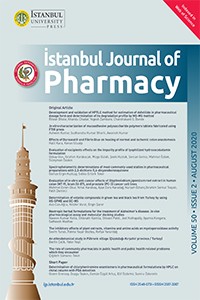In vitro characterization of mucoadhesive polysaccharide polymers tablets fabricated using FTIR press
Abstract
Background and Aim: Buccal/sublingual drug delivery is gradually becoming one of the most experimented routes for alternate drug delivery. The major advantage of both routes is their high vascularity that allows a substantial permeation of drugs into systemic circulation. Mucoadhesive biopolymers are the mainstay of a transmucosal drug delivery system. Methods: We formulated blank tablets of explored mucoadhesive biopolymers (sodium alginate, carboxymethyl cellulose, hydroxyl propyl methyl) cellulose using a combination of two at a time. The novelty of this script lies in the formation of tablets using the FTIR hydraulic press, as opposed toa conventional tablet punching machine, at two different pressures. The tablets were subjected to basic characterizations of polymeric interaction, hardness, and swelling behaviour. Results: An interaction analysis using XRD revealed a good interaction between the polymers. HC-300 and AC-300 were found to be the hardest among the tablets formulated. In terms of swelling behaviour, AC-200 and HA-300 displayed the best swelling as compared to other combinations. Conclusion: In the absence of a conventional tablet punching machine, we fabricated swellable biopolymeric tablets using the regular KBr hydraulic press that comes as an accessory with the FTIR instrument. These tablets can possible be used for delivering drugs through buccal mucosa.
Keywords
References
- Barua, S., Kim, H., Jo, K., Seo, C. W., Park, T. J., Lee, K. B. … Lee, J. (2016). Drug delivery techniques for buccal route: Formulation strategies and recent advances in dosage form design. Journal of Pharmaceutical Investigation, 46, 593–613. https://doi. org/10.1007/s40005-016-0281-9.
- Boddupalli, B. M., Mohammad, Z. N. K., Nath, R. A., & Banji, D. (2010). Mucoadhesive drug delivery system - an overview. Journal of Advanced Pharmaceutical Technology and Research, 1(4), 381–387. https://doi.org/10.4103/0110-5558.76436
- Favacho, H. A. S., do Couto, R. O., Duarto, M. P. F., Peixoto, M. P. G., Lopez, R. F. V., Pedrazzi, V, de Gaitani, C. M., & de Freitas, O. (2020). Synergy between surfactants and mucoadhesive polymers enhances the transbuccal permeation of local anesthetics from freeze-dried tablets. Material Science and Engineering: C, 108, 110373. https://doi.org/10.1016/j.msec.2019.110373.
- Mura, P., Cirri, M., Mennini, N., Casella, G., & Maestrelli, F. (2016). Polymeric mucoadhesive tablets for topical or systemic buccal delivery of clonazepam: Effect of cyclodextrin complexation. Carbohydrate Polymers, 152, 755–763. https://doi.org/10.1016/j. carbpol.2016.07.075
- Koland, M., Vijayanarayana, K., Charyulu, R. N., & Prabhu, N. (2011). In vitro and in vivo evaluation of chitosan buccal films of ondansetron hydrochloride. International Journal of Pharmaceutical Investigation, 1(3), 164–171. https://doi.org/10.4103/2230-973X.85967
- Shridhar, G. S., Manohar, S. D., & Bhanudas, S. R. (2013). Mucoadhesive buccal drug delivery: An overview. Journal of Advanced Pharmacy Education and Research,3(4), 319-332.
- Sudhakar, Y., Kuotsu, K., & Bandyopadhyay, A. K. (2006). Buccal bioadhesive drug delivery — A promising option for orally less efficient drugs. Journal of Controlled Release,114, 15–40. https:// doi.org/10.1016/j.jconrel.2006.04.012
- Vila, M. M., Tardelli, E. R., Chaud, M. V., Tubino, M., & Balcão, V. M. (2014). Development of a buccal mucoadhesive film for fast dissolution: Mathematical rationale, production and physicochemical characterization, Drug Delivery, 21(7), 530–539. https://doi.org /10.3109/10717544.2013.851301.
Abstract
References
- Barua, S., Kim, H., Jo, K., Seo, C. W., Park, T. J., Lee, K. B. … Lee, J. (2016). Drug delivery techniques for buccal route: Formulation strategies and recent advances in dosage form design. Journal of Pharmaceutical Investigation, 46, 593–613. https://doi. org/10.1007/s40005-016-0281-9.
- Boddupalli, B. M., Mohammad, Z. N. K., Nath, R. A., & Banji, D. (2010). Mucoadhesive drug delivery system - an overview. Journal of Advanced Pharmaceutical Technology and Research, 1(4), 381–387. https://doi.org/10.4103/0110-5558.76436
- Favacho, H. A. S., do Couto, R. O., Duarto, M. P. F., Peixoto, M. P. G., Lopez, R. F. V., Pedrazzi, V, de Gaitani, C. M., & de Freitas, O. (2020). Synergy between surfactants and mucoadhesive polymers enhances the transbuccal permeation of local anesthetics from freeze-dried tablets. Material Science and Engineering: C, 108, 110373. https://doi.org/10.1016/j.msec.2019.110373.
- Mura, P., Cirri, M., Mennini, N., Casella, G., & Maestrelli, F. (2016). Polymeric mucoadhesive tablets for topical or systemic buccal delivery of clonazepam: Effect of cyclodextrin complexation. Carbohydrate Polymers, 152, 755–763. https://doi.org/10.1016/j. carbpol.2016.07.075
- Koland, M., Vijayanarayana, K., Charyulu, R. N., & Prabhu, N. (2011). In vitro and in vivo evaluation of chitosan buccal films of ondansetron hydrochloride. International Journal of Pharmaceutical Investigation, 1(3), 164–171. https://doi.org/10.4103/2230-973X.85967
- Shridhar, G. S., Manohar, S. D., & Bhanudas, S. R. (2013). Mucoadhesive buccal drug delivery: An overview. Journal of Advanced Pharmacy Education and Research,3(4), 319-332.
- Sudhakar, Y., Kuotsu, K., & Bandyopadhyay, A. K. (2006). Buccal bioadhesive drug delivery — A promising option for orally less efficient drugs. Journal of Controlled Release,114, 15–40. https:// doi.org/10.1016/j.jconrel.2006.04.012
- Vila, M. M., Tardelli, E. R., Chaud, M. V., Tubino, M., & Balcão, V. M. (2014). Development of a buccal mucoadhesive film for fast dissolution: Mathematical rationale, production and physicochemical characterization, Drug Delivery, 21(7), 530–539. https://doi.org /10.3109/10717544.2013.851301.
Details
| Primary Language | English |
|---|---|
| Subjects | Pharmacology and Pharmaceutical Sciences, Health Care Administration |
| Journal Section | Original Article |
| Authors | |
| Publication Date | August 27, 2020 |
| Submission Date | June 18, 2019 |
| Published in Issue | Year 2020 Volume: 50 Issue: 2 |


